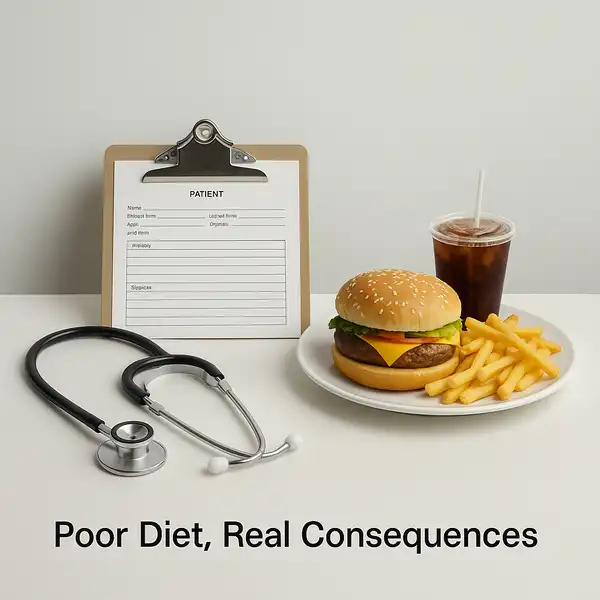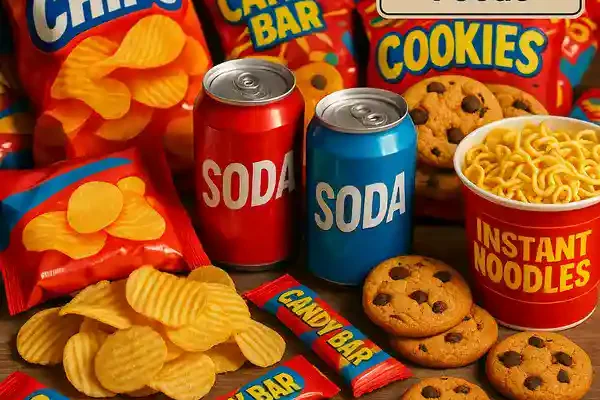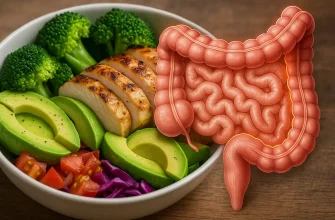The domino effect of poor nutrition begins quietly—with a few skipped vegetables or one too many processed meals—but over time, it sets off a chain reaction that can seriously impact your health. When the body is deprived of what it needs, the consequences ripple through nearly every system.
Most Common Diet-Related Diseases in the U.S. (2024)
This chart illustrates the prevalence of major diet-related diseases in the U.S. as of 2024. Hypertension and obesity top the list, affecting nearly half of the adult population. Heart disease remains a leading cause of death, while diabetes and stroke also contribute significantly to the public health burden.
1. Obesity and Metabolic Syndrome
Why it happens: A high intake of processed foods, sugars, and saturated fats contributes to weight gain and insulin resistance.
Disease overview: Obesity is a chronic condition where excessive body fat accumulates to the extent that it impacts health. It often coexists with metabolic syndrome—a cluster of conditions including high blood pressure, high blood sugar, excess abdominal fat, and abnormal cholesterol levels. Metabolic syndrome significantly increases the risk of heart disease, stroke, and type 2 diabetes.
Key facts:
- More than 42% of American adults are obese (CDC, 2023).
- Men are slightly more likely to develop metabolic syndrome than women, especially after age 40.
- Children and adolescents are now increasingly affected, with 1 in 5 classified as obese.
Case: A 38-year-old male from Houston, TX, developed metabolic syndrome after years of fast food consumption and minimal physical activity.
2. Type 2 Diabetes
Root cause: Excessive sugar and refined carbohydrates spike blood glucose levels.
Disease overview: Type 2 diabetes is a metabolic disorder where the body becomes resistant to insulin or fails to produce enough of it, leading to chronic high blood sugar. If unmanaged, it can damage organs, nerves, and blood vessels.
Modern insight: Continuous glucose monitors (CGMs) now help detect glucose fluctuations in real time, offering early warnings.
Key facts:
- Type 2 diabetes accounts for 90–95% of diabetes cases in the U.S.
- People over 45, especially with a sedentary lifestyle, are at higher risk.
- Hispanic, Black, and Native American communities show higher prevalence.
Diagnostic accuracy:
- HbA1c test: 9/10
- CGM: 8.5/10
Average cost:
- HbA1c: $35–$60
- CGM setup: $300–$1000
3. Cardiovascular Diseases
Culprits: Trans fats, sodium, and added sugars damage blood vessels and elevate LDL cholesterol.
Disease overview: Cardiovascular diseases include conditions like coronary artery disease, heart attacks, and strokes. These are the leading causes of death worldwide, largely preventable through healthy dietary choices.
Real talk:
A poor diet can be as risky for your heart as smoking. Yeah, really.
Key facts:
- About 697,000 people in the U.S. died from heart disease in 2020 (CDC).
- Men have a higher risk earlier in life, but women’s risk increases significantly after menopause.
- Diet-related hypertension is a major contributor to heart failure.
Case: A 62-year-old woman in Detroit, MI, required a stent placement after years of high-sodium, low-fiber eating.
4. Non-Alcoholic Fatty Liver Disease (NAFLD)
Link to diet: Too much sugar, particularly fructose, overwhelms the liver.
Disease overview: NAFLD is a condition where fat builds up in the liver without alcohol use. It can progress to more serious liver damage, including cirrhosis and liver failure.
Innovative diagnostics:
- FibroScan: Measures liver stiffness and fat.
- Accuracy: 8.7/10
- Cost: $200–$350
Key facts:
- Affects nearly 25% of U.S. adults.
- Often coexists with obesity and type 2 diabetes.
- More common in men, but postmenopausal women face increased risk.
Fun fact: The liver doesn’t complain until it’s in real trouble. That’s why early screening is gold.

5. Certain Cancers
Dietary risks:
- High red meat consumption → colorectal cancer
- Low fiber intake → slower gut motility and toxin accumulation
Disease overview: Poor diet can promote inflammation and oxidative stress, both of which are linked to cancer development. Stomach, colorectal, and esophageal cancers are strongly influenced by dietary habits.
Statistics:
- Poor diet is linked to 5% of all cancer cases in the U.S. (ACS, 2022).
- Colorectal cancer is more common in men, and risk increases after age 50.
Percentage of Cancer Cases Linked to Poor Diet (U.S., 2023)
This chart highlights the proportion of cancer cases attributed to poor dietary habits in the U.S. for 2023. Colorectal cancer stands out with the highest diet-related association, followed by pancreatic and postme
6. Osteoporosis
What’s missing: Not enough calcium, vitamin D, and magnesium.
Disease overview: Osteoporosis is a condition where bones become porous, brittle, and more likely to fracture. It often goes undetected until a bone breaks.
Big risk: Weak, brittle bones that break easily.
Key facts:
- Affects about 10 million Americans—80% of them women.
- Postmenopausal women are at the highest risk due to hormonal changes.
- Vertebral and hip fractures are the most serious consequences.
Recommended tests:
- DEXA scan (Dual-Energy X-ray Absorptiometry)
- Accuracy: 9.5/10
- Average cost: $125–$300
7. Depression and Anxiety
The gut-brain axis: Diet directly influences mental health through microbiota and inflammation.
Disease overview: Nutrient deficiencies, blood sugar fluctuations, and chronic inflammation can all contribute to mood disorders. A poor diet can impair neurotransmitter function and worsen symptoms of depression and anxiety.
Watch out for:
- High sugar → Mood crashes
- Nutrient deficiencies → Low serotonin and dopamine
Modern approaches: Nutritional psychiatry is a growing field bridging diet and mental health.
Key facts:
- Depression affects over 21 million U.S. adults annually (NIMH, 2022).
- Women are nearly twice as likely to experience depression as men.
- Adolescents with poor diet habits show higher rates of anxiety and depressive episodes.
Handy Reference Table
| Disease | Dietary Triggers | Recommended Test | Cost Range (USD) |
|---|---|---|---|
| Obesity/Metabolic Syndrome | Processed carbs, sugar, fried foods | Lipid panel | $50–$150 |
| Type 2 Diabetes | Refined carbs, sugar | HbA1c, CGM | $35–$1000 |
| Cardiovascular Diseases | Trans fats, salt, sugar | ECG, lipid panel | $50–$300 |
| NAFLD | High fructose, processed foods | FibroScan | $200–$350 |
| Cancers | Red/processed meat, low fiber | Colonoscopy, biopsy | $500–$3000 |
| Osteoporosis | Low calcium, vitamin D, magnesium | DEXA scan | $125–$300 |
| Depression/Anxiety | Sugar, nutrient-poor diet | Nutrient blood panel | $100–$400 |
Editorial Advice
Reyus Mammadli, healthcare advisor, recommends:
“Preventing disease through nutrition isn’t just about skipping soda or candy bars. It’s about making consistent, smart choices that give your body what it needs to thrive. Start small: swap white rice for quinoa or choose olive oil over margarine. These little decisions add up—big time.”
Top Dietary Risk Factors Leading to Disease (Global Impact Score)
This chart outlines global dietary risk factors with the highest impact scores. High sodium intake remains the most critical contributor to diet-related diseases, followed by insufficient fruit and whole grain c
Modern technologies like continuous glucose monitors and FibroScan devices are making early detection easier than ever. Combine that with regular blood work and smart eating habits, and you’re setting yourself up for a longer, healthier ride.
Oh—and don’t forget to treat your plate like a medicine cabinet. Just way tastier.
References
- Centers for Disease Control and Prevention (CDC). “Adult Obesity Facts.” Updated May 2023. https://www.cdc.gov/obesity/data/adult.html
- American Diabetes Association. “Statistics About Diabetes.” Accessed 2024. https://diabetes.org/about-diabetes/statistics
- National Heart, Lung, and Blood Institute (NHLBI). “Cardiovascular Diseases.” Accessed 2024. https://www.nhlbi.nih.gov/health-topics/cardiovascular-diseases
- American Liver Foundation. “Nonalcoholic Fatty Liver Disease.” Accessed 2024. https://liverfoundation.org/for-patients/about-the-liver/diseases-of-the-liver/nafld/
- American Cancer Society (ACS). “Diet and Physical Activity: What’s the Cancer Connection?” Updated 2022. https://www.cancer.org/cancer/cancer-causes/diet-physical-activity.html
- National Osteoporosis Foundation. “What is Osteoporosis?” Accessed 2024. https://www.nof.org/patients/what-is-osteoporosis/
- National Institute of Mental Health (NIMH). “Major Depression.” Updated 2022. https://www.nimh.nih.gov/health/statistics/major-depression
- Harvard T.H. Chan School of Public Health. “The Nutrition Source – Healthy Eating Plate.” Accessed 2024. https://www.hsph.harvard.edu/nutritionsource/
- Mayo Clinic. “Metabolic Syndrome.” Accessed 2024. https://www.mayoclinic.org/diseases-conditions/metabolic-syndrome/symptoms-causes
- Cleveland Clinic. “Depression and Diet: Can Food Affect Your Mood?” Updated 2023. https://health.clevelandclinic.org/depression-and-diet








